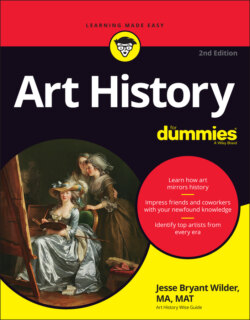Читать книгу Art History For Dummies - Jesse Bryant Wilder - Страница 15
Ancient Greek period (c. 850 BC–323 BC) and Hellenistic period (323 BC–32 BC)
ОглавлениеBecause of the conquests of Alexander the Great (356 BC–323 BC) and the later Roman love affair with Greek culture, the art produced in the city-states of Ancient Greece spread from the British Isles to India, changing the world forever. Even studying a few Ancient Greek vases can reveal a lot about our times — if you know how to read the vases. Many Greek vases show us what Ancient Greek theater looked like; modern theater and cinema are the direct descendants of Greek theater (see Chapter 7). Greek vases depict early musical instruments, dancers dancing, and athletes competing in the ancient Olympics, the forerunner of the modern Olympic Games. Some vases show us the role of women and men: Women carry vases called hydrias; men paint those vases. Modern gender roles are still affected, and in some cases driven, by ancient ones.
The Greeks invented techniques like red-figure painting, the contrapposto pose (in which a human figure stands gracefully at ease with most of its weight on one foot), and perspective to enable artists to represent the world realistically (see Chapter 7). But as real looking as classical Greek art is, it is also idealized (made to look better than real life). Greek statues don’t have pot bellies or receding hairlines. Art of the classical period (when Greek art peaked) is known for its otherworldly calm and beauty. The Hellenistic period (the extension of Greek culture via the conquests of Alexander the Great) added realism and emotion to the Greek’s art palette.
